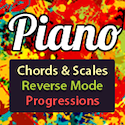Well, I didn’t plan to live blog at all from the conference, but since I have free wi-fi here and I”m sitting in an interesting workshop, I figured, why not? 🙂

Nancy Blockcolsky, our KMTA President-Elect, is giving this workshop – Improvising is Easy! – and is giving us a systematic approach to teaching improvisation to students. Trilla demonstrates at the piano as Nancy instructs.
Prerequisites for this type of improvising:
1. A melody
2. Some knowledge of chords
3. A basic knowledge of scales
She started with Mary Had A Little Lamb and had Trilla play the melody as written while adding blocked chords in the left hand. Then she had her improvise an alternate accompaniment pattern.
Melodic Improvisation
1. Change the intervals. As you experiment with changing the melody, keep in mind what makes a good melody. A good melody is singable and memorable. What makes a melody singable?
* Use of step-wise motion.
* Movement by skips involves the use of chord tones or notes adjacent to chord tones.
* The melody has line and direction (meaning).
A singable melody also often uses motives. A singable melody will be slightly predictable as well.
A memorable melody will have the same properties as a singable melody, but it will also involve some repetition, possibly through the use of parallel phrases.
2. Change the Rhythm
Harmonic Improvisation – simply changing the chords that are using. This takes a little bit of forethought (unless you’re really experienced). Look at the note or notes you want to put the chords with. For example, in the first measure, the first note of the melody is E. E can function as the root of a chord, the third, the fifth, the seventh, etc. Chords that use E – Diatonic to C Major:
* C Major
* E minor
* A minor
* F Major7
* D minor9
Chromatic (borrowed) chords that use E:
* C# minor
* A Major
* E Major
* F#7
* F# minor7
* C7
Nancy put some alternate harmonization to Mary Had A Little Lamb to demonstrate some of the possibilities (some more musical than others!). Very interesting!
Nancy gave some suggestions for those who want to go farther:
1. Learn more chords, scales, etc.
2. Listen to different types of music.













Leave a Reply